Amana CHEST FREEZER User Manual
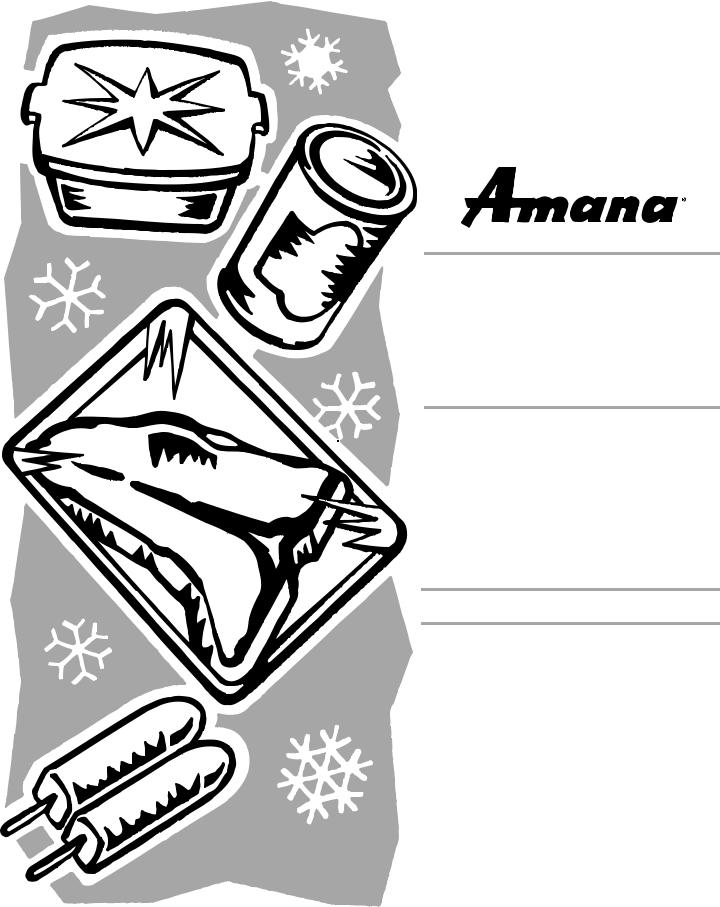
CHEST FREEZER
Use & Care Guide
For questions about features, operation/performance, parts or service, call: 1-800-843-0304.
In Canada, call for assistance 1-800-807-6777,
or visit our website at...
www.amana.com or www.amana.ca
CONGÉLATEUR
COFFRE
Guide d’utilisation et d’entretien
Au Canada, pour assistance, composez le 1-800-807-6777.
ou visitez notre site web à www.amana.ca
Table of Contents/Table des matières .................. |
2 |
W10635013B

TABLE OF CONTENTS
FREEZER SAFETY....................................................................................... |
3 |
FREEZER CARE .......................................................................................... |
6 |
Proper Disposal of Your Old Freezer or Refrigerator ............................... |
3 |
Defrosting and Cleaning Your Freezer ..................................................... |
6 |
INSTALLATION INSTRUCTIONS ............................................................... |
4 |
Power Interruptions .................................................................................. |
7 |
Unpacking................................................................................................. |
4 |
Moving Care ............................................................................................. |
7 |
Location Requirements............................................................................. |
4 |
TROUBLESHOOTING ................................................................................. |
8 |
Electrical Requirements............................................................................ |
5 |
ASSISTANCE OR SERVICE........................................................................ |
9 |
FREEZER USE ............................................................................................. |
5 |
In the U.S.A............................................................................................... |
9 |
Using the Control...................................................................................... |
5 |
In Canada.................................................................................................. |
9 |
Indicator Lights ......................................................................................... |
6 |
WARRANTY ............................................................................................... |
10 |
Sliding Basket ........................................................................................... |
6 |
|
|
TABLE DES MATIÈRES
SÉCURITÉ DU CONGÉLATEUR............................................................... |
11 |
ENTRETIEN DU CONGÉLATEUR ............................................................ |
15 |
|
Mise au rebut appropriée de votre vieux congélateur ou réfrigérateur . 12 |
Dégivrage et nettoyage du congélateur................................................. |
15 |
||
INSTRUCTIONS D'INSTALLATION ......................................................... |
12 |
Pannes de courant électrique................................................................. |
16 |
|
Déballage ................................................................................................ |
12 |
Déménagement ...................................................................................... |
16 |
|
Exigences d’emplacement ..................................................................... |
12 |
DÉPANNAGE ............................................................................................. |
16 |
|
Spécifications électriques....................................................................... |
13 |
ASSISTANCE OU SERVICE...................................................................... |
18 |
|
UTILISATION DU CONGÉLATEUR .......................................................... |
14 |
GARANTIE |
19 |
|
Utilisation de la commande |
14 |
|||
|
|
|||
Témoins lumineux................................................................................... |
14 |
|
|
|
Panier coulissant..................................................................................... |
14 |
|
|
|
2
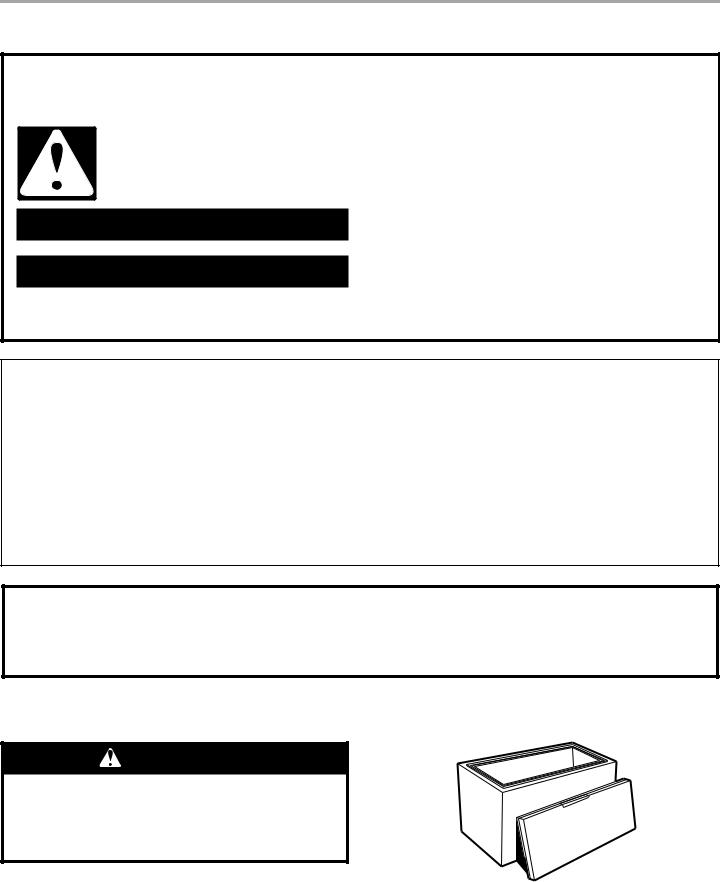
FREEZER SAFETY
Your safety and the safety of others are very important.
We have provided many important safety messages in this manual and on your appliance. Always read and obey all safety messages.
This is the safety alert symbol.
This symbol alerts you to potential hazards that can kill or hurt you and others.
All safety messages will follow the safety alert symbol and either the word “DANGER” or “WARNING.” These words mean:
 DANGER
DANGER
 WARNING
WARNING
You can be killed or seriously injured if you don't immediately follow instructions.
You can be killed or seriously injured if you don't follow instructions.
All safety messages will tell you what the potential hazard is, tell you how to reduce the chance of injury, and tell you what can happen if the instructions are not followed.
IMPORTANT SAFETY INSTRUCTIONS |
|
WARNING:To reduce the risk of fire, electric shock, or injury when using your freezer, follow these basic precautions: |
|
■ Plug into a grounded 3 prong outlet. |
■ Keep flammable materials and vapors, such as gasoline, |
■ Do not remove ground prong. |
away from freezer. |
■ Do not use an adapter. |
■ Use two or more people to move and install freezer. |
■ Do not use an extension cord. |
■ Keep key away from children. |
■ Disconnect power before servicing. |
■ Remove doors or lid from your old freezer or refrigerator. |
■ Replace all parts and panels before operating. |
■ Disconnect power before installing ice maker (on ice maker |
■ Use nonflammable cleaner. |
kit ready models only). |
|
|
SAVE THESE INSTRUCTIONS
State of California Proposition 65 Warnings:
WARNING: This product contains one or more chemicals known to the State of California to cause cancer.
WARNING: This product contains one or more chemicals known to the State of California to cause birth defects or other reproductive harm.
Proper Disposal of
Your Old Freezer or Refrigerator
IMPORTANT: Child entrapment and suffocation are not problems of the past. Junked or abandoned freezers or refrigerators are still dangerous ... even if they will sit for “just a few days.”
WARNING
Suffocation Hazard
Remove doors or lid from your old freezer or refrigerator.
Failure to do so can result in death or brain damage.
BEFORE YOU THROW AWAY YOUR OLD FREEZER OR
REFRIGERATOR REMOVE THE DOORS OR LID.
3
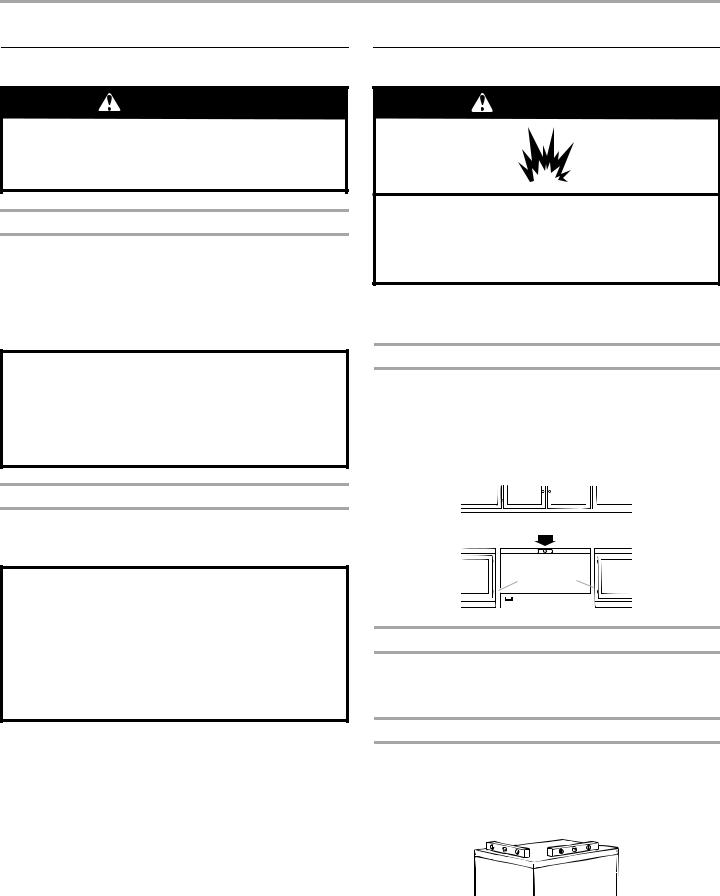
INSTALLATION INSTRUCTIONS
Unpacking
WARNING
Excessive Weight Hazard
Use two or more people to move and install freezer. Failure to do so can result in back or other injury.
Remove Packaging Materials
■Remove tape and glue residue from surfaces before turning on the freezer. Rub a small amount of liquid dish soap over the adhesive with your fingers. Wipe with warm water and dry.
■Do not use sharp instruments, rubbing alcohol, flammable fluids, or abrasive cleaners to remove tape or glue. These products can damage the surface of your freezer. For more information, see “Freezer Safety.”
When Moving Your Freezer:
Your freezer is heavy. When moving the freezer for
cleaning or service, be sure to cover the floor with cardboard or hardboard to avoid floor damage. Always pull the freezer straight out when moving it. Do not wiggle or “walk” the freezer when trying to move it, as floor damage could occur.
Clean Before Using
After you remove all of the packaging materials, clean the inside of your freezer before using it. See the cleaning instructions in “Freezer Care.”
Important information to know about glass shelves and covers:
Do not clean glass shelves or covers with warm water when they are cold. Shelves and covers may break if exposed to sudden temperature changes or impact, such as bumping. Tempered glass is designed to shatter into many small, pebble-size pieces. This is normal. Glass shelves and covers are heavy. Use both hands when removing them to avoid dropping.
Location Requirements
WARNING
Explosion Hazard
Keep flammable materials and vapors, such as gasoline, away from freezer.
Failure to do so can result in death, explosion, or fire.
IMPORTANT: Check the strength of the floor before installing your freezer. It should hold the weight of a freezer fully loaded with food.
Ventilation and Clearance
■Keep flammable materials and vapors, such as gasoline, away from freezer.
■Do not cover the freezer with items such as blankets, sheets, tablecloths, etc. This reduces air circulation.
■Allow at least a 3" (7.5 cm) clearance on both sides of the freezer and 2" (5 cm) between the back of the freezer and the wall. Leave room above the freezer to open the lid.
2" (5 cm)
3" (7.5 cm) 
Temperature
Your freezer operates most efficiently when located in an area where the temperature is normally between 32°F (0°C) and 110°F (43°C). Do not install the freezer near an oven, radiator or other heat source.
Upon Moving to Final Location
1.Level the freezer from side to side and front to back so that the lid will seal properly. Use shims to level the freezer if necessary.
NOTE : It should not be necessary to remove the lid during installation. If, for any reason, the hinges need adjustment, contact a designated service company.
4
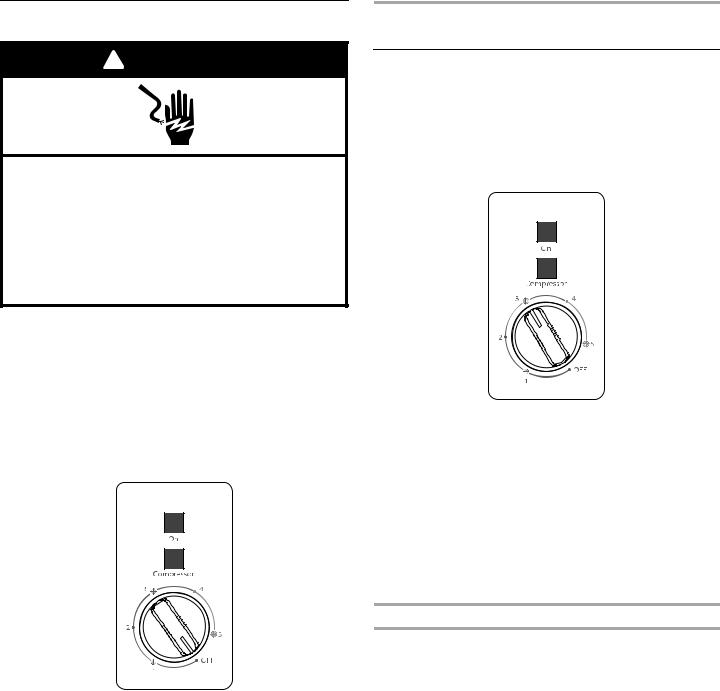
Electrical Requirements
 WARNING
WARNING
Electrical Shock Hazard
Plug into a grounded 3 prong outlet.
Do not remove ground prong.
Do not use an adapter.
Do not use an extension cord.
Failure to follow these instructions can result in death, fire, or electrical shock.
Before you move your freezer into its final location, it is important to make sure you have the proper electrical connection.
Recommended Grounding Method
A 115 Volt, 60 Hz, AC only, 15-amp fused and grounded (earthed) electrical supply is required.
It is recommended that a separate circuit serving only your freezer be provided. Use an outlet that cannot be turned off by a switch. Do not use an extension cord.
NOTE: Before performing any type of installation or cleaning, turn the Temperature Control to the OFF position as shown and then disconnect the freezer from the electrical source.
FREEZER USE
Using the Control
Turn the freezer temperature control to 3. This setting is designed to maintain the temperature at or near 0°F (-17.8°C) under normal operating conditions.
IMPORTANT: Allow the freezer to cool 6 to 8 hours before filling with frozen food. Let the freezer cool overnight before adding large amounts of unfrozen food. Do not add more than 2 to 3 lbs (0.907 to 1.360 kg) of unfrozen food per cubic foot of freezer space.
NOTES:
■When the freezer is first started, the compressor will run constantly until the interior is cooled. It may take 6 to 8 hours (or longer), depending on location, room temperature and the number of times the freezer lid is opened.
■After the cabinet is cooled, the compressor will turn on and off as needed to keep the freezer at the proper temperature.
■Each time the lid is opened, cold air escapes and the temperature inside the freezer rises.
■The outside of your freezer may feel warm. This is normal. The freezer’s design and main function is to remove heat from the contents and air inside the freezer. The heat is transferred to the room air, making the outside of the freezer feel warm.
Adjusting the Control
■Turn control to a higher number for colder temperatures.
■Turn control to a lower number for less cold temperatures.
5
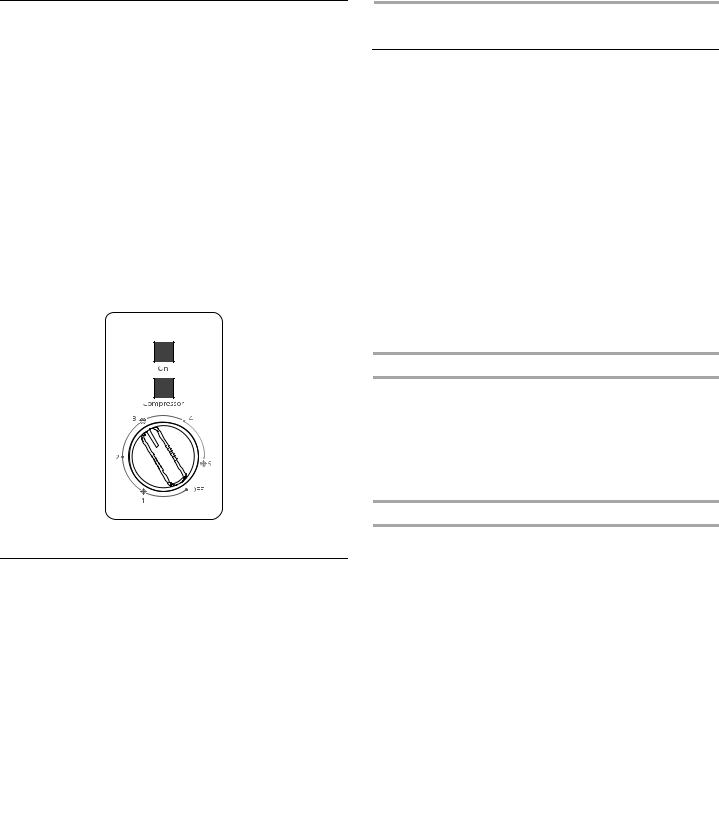
Indicator Lights
The indicator lights are located on the front of the freezer above the control. The lights assure you that your freezer is operating. The indicator lights are LED which do not need to be replaced.
ON indicator light - shows you that there is power to the freezer.
COMPRESSOR indicator light - shows you that the compressor is running.
If the ON indicator light is not illuminated, immediately check for:
■A power interruption.
■An unplugged power cord.
■An open circuit breaker or blown fuse.
NOTE: If there is power to the freezer, and the ON indicator does not illuminate, the indicator light may be burned out. Call Service to replace the indicator lights.
If the COMPRESSOR indicator is not illuminated: the compressor is in its off cycle.
NOTE: The compressor automatically cycles off and on to maintain the desired temperature.
 A
A
A. Indicator lights
Sliding Basket
Store small packages in the basket to avoid losing them in the bottom of the freezer. The basket can then be moved from side to side or it can be removed when loading or unloading the food below it.
To remove basket, lift it straight up and out. To replace basket, lower basket back into place.
FREEZER CARE
Defrosting and Cleaning Your Freezer
WARNING
Use nonflammable
Failure to do so can result in death, explosion, or fire.
Accumulation of frost and ice will lessen the performance of the freezer. Complete defrosting and cleaning should be done at least twice a year or when frost has built up to about ¹⁄" (0.6 cm) thickness. In high humidity areas, a freezer may need more frequent defrosting and cleaning.
Before Defrosting
1.Turn the temperature control dial to setting 5, approximately 6 hours before defrosting, to ensure frozen food is at the lowest temperature before removing it from the freezer.
2.Remove all frozen food. Wrap frozen food in several layers of newspaper and cover with a blanket. Food will stay frozen for several hours. You may also store frozen food in a cooler, additional refrigerator-freezer, or in a cool area.
3.Remove the freezer basket and leave the lid open.
Defrosting
1.Unplug freezer or disconnect power.
2.Remove the rubber cap from the drain on the freezer floor by pulling it straight up. Set the cap aside until defrosting is completed.
3.Place containers of warm water in the freezer, keeping the lid open, to speed melting. As the ice melts, water will collect on the bottom of the freezer.
4.Use a plastic scraper to remove frost.
NOTE: Do not use electrical appliances such as hair dryers or heaters to speed defrosting. Do not use an ice pick, knife, or other sharp-pointed tool to defrost freezer. Damage can occur.
6
